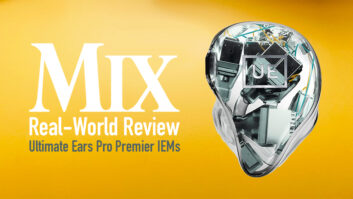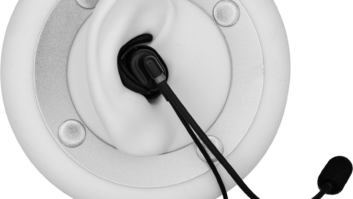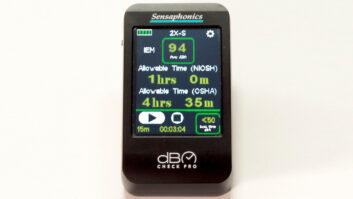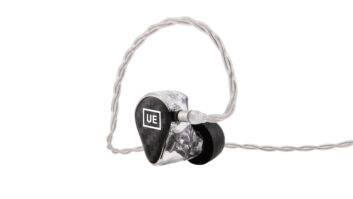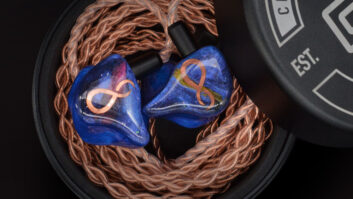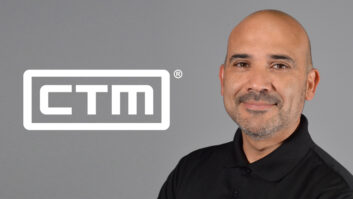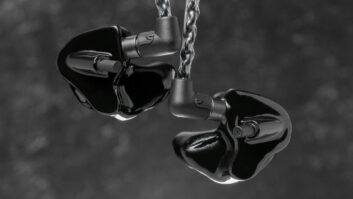It’s way too early to proclaim stage wedges an endangered species, but there’s no question that the use of in-ear monitoring (IEM) systems is rising rapidly, and that what once seemed like a luxury item for the top echelon of bands is increasingly being employed by performers up and down the economic ladder. There are more IEM systems at different pricepoints available today than ever before, and the technology in both the ear pieces and the transmitters continues to improve as the competition among manufacturers heats up.
The main reasons why musicians and singers turn to IEMs are fairly simple: The earpieces offer hearing protection because they block out stage sound to varying degrees (and, if desired and feasible, allow for the removal of amplifiers to an offstage location, further reducing stage volume); IEMs let the user hear his or her own part more distinctly, which is particularly important for singers to maintain pitch; they provide a largely consistent mix even if the performer moves around a lot onstage; and they streamline the overall production process by eliminating the need for wedges and sidefills, making for a more spacious stage and considerably easier storage, transport and setup.
That said, IEMs are not a panacea for everyone. Some musicians don’t like the way they feel. Some don’t like the way they can isolate performers from their audience. Some love the relatively open sound of wedges and have no desire to change. In some groups, one or two members have switched to IEMs while the others stayed on wedges. Some even use a combination — an earpiece in just one ear, plus wedges. There are no absolutes; it’s a matter of preference, as in all things audio.
A year ago, in our January 2001 issue, Mix sound reinforcement editor (and professional live sound engineer) Mark Frink wrote an excellent primer on the strengths and weaknesses inherent in IEM technology and some practical tips for navigating through this still relatively new sonic world. His article, titled “All Quiet on the Wedgeless Stage,” is easily accessible on our Website, mixonline.com, and I recommend it highly to anyone looking for basic, practical information about IEMs.
This year, for a change of pace, we spoke with four top monitor engineers about some of their experiences using IEMs.
BRENT DANNEN
A Dallas native who lived in Nashville for a decade and now resides in Southern California, Brent Dannen has worked monitors in many styles of music, including alternative rock with Dave Navarro, pop with Enrique Iglesias, country with Garth Brooks and Faith Hill, and jam-rock with Widespread Panic. We began our discussion talking about why Garth Brooks doesn’t use IEMs.
“He just isn’t an in-ear monitor guy; some people aren’t. He’s perfectly happy with his 63 wedges,” Dannen laughs. “Garth is not about the perfect sound and the perfect mix. He’s about the perfect show for the crowd. It’s a big stage, and the crowds are so loud; I have yet to experience a louder crowd, and I doubt I ever will. So, those wedges had to be real loud. He said he didn’t want to take any chance with that, isolating himself with in-ears.
“There’s the right tool for the job,” he continues. “Just like a mechanic doesn’t use a flat-head screwdriver to screw in a Phillips head nut, in-ear monitors are the right tool for certain jobs, but they’re not the right tool for everybody, and they weren’t the right thing for Garth Brooks. It is a good tool to isolate from loud crowd situations, but that’s not what he’s looking for.”
As we spoke, Dannen was driving to Los Angeles to be crew chief and mix monitors for an eight-act mini-festival at the Wiltern Theater featuring Sugar Ray, The Deftones, Third Eye Blind and others, and he knew going in that he would be mixing for both ears and wedges. “I’ll have four in-ear monitor systems there and a dozen wedge mixes. Some bands are using both. Some bands are using just ears. Some are using all wedges. I own all sorts of different brands, though my personal favorites are Ultimate Ears. If someone comes in with Future Sonics, which are probably the most popular, I want to be able to work with them, too. For me, there are three companies that are competing, and they’re all pretty good: Future Sonics, Ultimate Ears and Sensaphonics.”
In reality, of course, there are a number of other players in the field, including the British company Garwood, whose new System 24 was profiled in the December Mix, plus there’s Sony, Shure, Sennheiser and more. And, as happened with modular digital multitracks, there are now some IEMs being made by one company and licensed to another. “Jerry Harvey [of Ultimate Ears] was on the design team for the Shure E5s,” Dannen says. “I mix and match. A lot of times, it’s not a question of what I desire; there are budget considerations.”
Dannen says that he prefers Ultimate Ears because, “They seal better, and their frequency response is better than the other brands I’ve used.” He notes that, “Future Sonics are dynamic speakers, and there are two problems with dynamic speakers for me, personally, as an engineer. Other people might think these are good things. One, you have to have a port to the outside world; you can’t 100-percent isolate, so you get a certain amount of ambient noise. Two, no two dynamic speakers sound exactly the same. No two ears are exactly the same or have the same-sized cavity; the box enclosure is different sizes, so every one is going to sound a little different. When I show up with a set of ear molds in my ears and I stick a set in the artist’s ears, I want my ears to sound exactly like the artist’s so I’ll know exactly what he’s hearing. And I don’t feel I get that exact replication with dynamic speakers. Ultimate Ears is an enclosed box; it doesn’t need a port, and they all sound exactly the same; or if not exactly, so close I can’t tell the difference.”
That said, it should be noted that some of Ultimate Ears’ latest models make concessions to the desires of many musicians to hear some stage sound. “They have these new Ambient molds where you can allow yourself to hear the outside world, and they also have a dual low-end driver and have extended high frequency,” Dannen says.
“When I mixed Widespread Panic”, he continues, “I was able to contour each system individually. On three of the guys, I put on Ambients and they have different ports, so you can have different levels of bleed.
With Widespread Panic, too, Dannen augmented his regular ear mix for the band “by putting up a few ambient microphones — Audio Technica 4041s — up onstage. I put one downstage left and right pointing toward the drum kit so it’s kind of angling across the stage. I put one in front of the stage-right guitar player and one in front of the stage-left bass player, and I put one upstage on a real tall boom, kind of pointing down. Then I panned them around in their ears according to how they were sitting onstage, mixing the live feed from the stage with the direct signal. They liked that a lot; it sounded very natural to them.”
Dannen echoes the sentiments of most monitor mixers when he says, “In mixing in-ear monitors, it’s very, very important to keep stage volume as low as you can, because it is the number one offender. If you’re not taking the amps offstage, you’ve got to pay a lot of attention to stage level.
“You also have to watch your microphones. I was having this phenomenon for a while and I couldn’t understand it: We’ve got ear molds, we’re able to get just as much volume with vocal mics as we want, without feedback. But some of the singers I was working with were still having some trouble being on pitch. So, I took some singing lessons — and I don’t sing — because I wanted to understand this. And one thing I learned is that if you have a microphone turned up too loud, the singer can’t push because it’s too loud. They have to sing more quietly, and then there’s not enough air passing through the vocal chords, which means they have to tighten their vocal chords more than they normally would if they were singing at a natural volume, to achieve the same note. And that makes it harder for them to achieve correct pitch. So, if your singer is having a hard time keeping pitch, check the volume. Experiment. If they’re flat, try turning it down a little bit.”
Some artists have taken to wearing just one earpiece and listening to wedges with the other ear. But Dannen doesn’t approve of that approach: “I have a huge opinion on that. You can try this experiment: Take a set of headphones and pull your left ear off. All of a sudden, your right ear appears as if it’s quieter, so you have to turn that ear up louder to achieve the same apparent volume. That’s psychoacoustics, and now you’re ruining your hearing.”
DAVID “TREE” TORDOFF
One of the top monitor engineers in Great Britain, David “Tree” Tordoff has spent much of the past six years working with the great British band Radiohead. (See the Tour Profile in the October 2001 Mix.) He’s also done monitors for UK acts such as Lloyd Cole, John Cale, Supergrass, Marillion and others. As of their most recent tour, Radiohead are using IEMs on singer/leader Thom Yorke and drummer Phil Selway, and wedges on the rest of the band, a combination that seems to be working well so far. In this case, both the wedges and the in-ears were supplied by Firehouse Productions: The IEMs are the highly regarded dual-driver Firehouse 6500s, used in conjunction with a Shure PSM700 beltpack.
“I went through a long process before arriving at the Firehouse in-ears,” Tree explains. “We tried various models over the years, and Thom Yorke finally settled on certain characteristics he wanted. We felt that dual-driver ones all sound better than single-driver ones. He preferred silicon material to acrylic, because he wanted something slightly softer. And he wanted the shape to be the larger kind, so it held more solidly in his ear. He finds that as he performs, he gets hot and sweaty, and, if it’s not the larger shape, it starts to unscrew out of his ear. Anyway, no one seemed to be making something with those three characteristics. I was moaning about this to Bryan at Firehouse, and he suggested we try his Firehouse ones. Technically, it’s acrylic, rather than silicon, but it’s a softer, smoother version, and Thom thought they were fine.
“I think one of the most important things about in-ear monitors is that they should fit properly and give you a measured isolation so you’re actually listening to the in-ear monitor and a fixed mix of other sounds”, he continues. “You can have ports and things like that, but it must be controlled. If it’s a bad fit, the mix of in-ear sound and leaking sound is never the same from day to day, and you don’t have a consistent environment, which makes it very difficult to mix for. With some of these systems, it’s like listening with the door banging open and shut and the outside noise coming and going. So, the fit is really important, and the best way to get them to fit really well is to use the softer material and a larger mold. For someone like Celine Dion or Kylie Minogue, you might want the smallest, most discreet ones you can get, but if you’re in a rock band, it probably doesn’t matter as much. I know the first ones Thom ever ordered, he said, ‘Oh, can I have them in green?’ He doesn’t care if people see them. But different people have different priorities.
“Ed O’Brien, who plays guitar and does backing vocals, had a phase of using in-ears when he was very worried about singing backup vocals. It’s hard to sing backup vocals for someone like Thom Yorke, who’s such a good singer and expects the very highest from everyone around him. I think Ed was lacking confidence, and the in-ears helped him a lot with his singing. Nevertheless, he eventually felt he couldn’t hear his guitar amp properly and that’s his primary role in the band, so once he’d spent a year using IEMs and increased his singing confidence, he got rid of them and went back to listening to his amp and singing with wedges again. With in-ears, you always win on the hearing of your own voice, but you always kind of lose in hearing the instruments, particularly if you’re a guitarist; guitarists always feel like what they hear from the amp is the real sound of their guitar, not what’s coming through the P.A. or the wedges. And in the case of in-ears, it’s even further removed from the real sound of the amp. To me, it sounds fine, but to the guitarists, they hear more subtleties from the amplifiers.”
Actually, Thom Yorke uses a combination of IEMs and wedges. “He uses the in-ears for his voice, but he has all the drums and certain other instruments in the wedges. There are certain things he doesn’t want to hear right in his ears, like [keyboardist] Jonny Greenwood for example! It does eat up mixes, though: Yorke and O’Brien use four each [for stereo ears and wedges and reverb sends], and Phil Selway uses three [for stereo ears and stool shaker].”
On the issue of stereo vs. mono for IEMs, Tree comments, “Some people think that doing them in stereo is a waste of time, but I think it’s quite useful to separate things left and right. Obviously, if the singer turns around, the left and right image doesn’t change with him, and it can be a little disorienting. I don’t think you want to necessarily pan things spatially to match things on the stage, but I’m a firm believer that if you put the guitar on one side and the keyboard on another, you can psychologically mix the two things yourself in your head if you hear them coming from a separate place, and that gives the singer more control. Others say if you do it in mono, you get a stronger radio signal, because the two channels back each other up and all that, but I haven’t had any trouble with that. The stereo obviously gives you a little more space to work with, and that’s important when you’re talking about putting sound directly in a person’s ear. It’s more natural that way and, I suspect, easier to sing to.”
BLAKE SUIB
Blake Suib has been using IEMs since the late ’80s, when he helped the Steve Miller Band become the first major group to eliminate stage amps and go entirely on ears. Most recently, he was the monitor supervisor and a mixer on Madonna’s recent tour, worked with Axl Rose, and did a number of different segments of the Concert for New York City show, including songs by David Bowie, Mick Jagger, Eric Clapton/Buddy Guy, the Backstreet Boys and others.
When he and I spoke, he had just returned from Madonna’s Drowned World Tour, which, as you might imagine, was quite an undertaking from every perspective. Originally, Madonna was wary of using IEMs, “But once we went into rehearsals and she saw that it could almost be like a recording studio situation, and that she could have anything she wanted with all the effects just like the record, she changed her opinion. So, when she saw the capability of these things, she invited most of the producers and engineers she’s ever worked with to come down and critique my work. When they all went to her and said it was great, don’t change a thing, she decided she wanted one of her producers — Pat McCarthy — to come on tour, so the end result was a combination of what I, the live engineer, would do, but also what her producer would do, because she was looking at it like a studio situation. So, Pat McCarthy and I did her ear mix, and we took my third man, Marty Strayer, and made him the band’s monitor guy.
“The biggest mistake a lot of engineers make is to give the artist in-ear monitors before the mix is completely dialed,” he continues. “And what I mean is, take an artist like Madonna or Axl — you want to make sure you have the band in a rehearsal or soundcheck situation for a while before the artist ever comes in, so when you go and hand them their in-ear monitors and beltpack, you’ve got your mix 100 percent dialed, so they either say, ‘This is great,’ or ‘This sucks.’ You don’t want to get in a situation where the first day they have to say, ‘Turn up, turn down, do this, do that.’ It gets to the point where, after they’ve gotten used to the initial great sound that you can give them, then they can go song by song and say, ‘On this one, I want a little more drums. On this one, I want a little less,’ and so on and so forth.”
Suib has long been an enthusiastic user of Future Sonics Ear Monitors, but he likes Ultimate Ears also. “What Marty has is a really flat, good-sounding in-ear monitor, and on top of it, his shell is very comfortable,” he says. “It’s a hard shell, and it doesn’t have the suction cup effect in your ears that completely cuts you off from the real world. That’s good and bad: It’s good because the artist doesn’t feel cut off, but with a really loud band you are going to get a fair amount of bleed coming through. The Ultimate Ear monitor seals you off a lot more, and you can change the sound of the ear piece a lot more, so it depends on the situation as to which in-ear monitor I have my artist use. It’s pretty much the same way you pick a microphone: What’s best for what you are trying to do?”
Suib says he’s keen on the new Sennheiser beltpack transmitter system adding, “It just sounds better than anything out there. The other thing that’s important is to be listening at the same level. For example, with Madonna, whenever she or the musicians changed their volume, they had to give me a signal to let me know they were turning up or down so I could turn up or down, because if they’re listening at 6 and I’m listening at 4, everything translates differently, and they’re going to wonder why they’ve got a different mix. She understood that, and she always made sure she was at the same volume I was at so we were hearing the same thing.”
He also notes that the mix that any engineer creates for musicians using IEMs is also affected by the room and the P.A. “Probably the best-sounding arena in the country is Madison Square Garden, and it’s for one reason only,” he says. “The ceiling height is about half of most of the new arenas. There’s that much less reverb time on your mix. It’s very simple. A bad arena means you make a lot more changes. Any live mics on the stage need to be turned up and down a lot more in an ambient room than they do in a dead room, especially the vocal mics. The one thing you can use, EQ-wise, to control bad rooms is usually in the low midrange, from say 200 to 500 cycles; it’s usually not high end or extreme low.
“A lot of times, you want to boost some high end on your band mix,” he continues. “Then when you turn the vocal mic on, you get so much sizzle that you kind of have to go back and forth. So, we used a matrix out for Madonna’s ear mix. That means there were four sends going to her ear mix. Two of them were a band mix, two of them were the vocal mix, and then I inserted an EQ on the band mix so I could then boost the high end I wanted to boost on the band mix without having it affect the vocal mics, which is where the bleed comes from. All of a sudden, I could now get a crisp, bright ear mix without hurting someone, and have the sizzle come through.
“You’ve got to keep an open mind, because it’s like records: If people went in and only made records in one way, we’d never hear different kinds of music. I’m always learning, always experimenting.”
KRIS UMEZAWA
Kris Umezawa got his first break in 1996 while he was a P.A./stage tech for Maryland Sound and was called upon to mix Patti Smith, who was opening for Neil Young. She called him back to go to Japan and Australia, and the following summer he worked on David Byrne’s year-and-a-half Feelings Tour. Next came Everlast, then FOH for up-and-coming singer/songwriter Leona Naess, and then back to monitors with Widespread Panic. For much of 2001, he’s been back out with David Byrne, who is supporting his Look Into the Eyeball album with a nine-piece group that includes six string players. (See Mix “All Access,” September 2001.) Two recent tour breaks have allowed him to work with both Cyndi Lauper and the Beastie Boys.
The shows on this David Byrne tour were relatively modest productions — mostly 1,000- to 2,000-seat venues in the U.S. and Europe — but notable in part for how good they sounded and smoothly they ran, despite inherent budget limitations. Byrne has used in-ears for some time, but he has eschewed the higher-priced models, preferring to use “molds with Sony buds in them,” Umezawa says. “They’re off-the-shelf Sony headphones that sit in your ears. We have each performer’s ears molded, and then a piece is made from that mold that the bud sits in. On the Feelings Tour, we started out with Firehouse units and David also tried the Ultimate Ears at that time. He thought the custom pieces had better isolation but preferred the fidelity of the Sony buds. David’s been comfortable with this for several tours now, and his attitude is, why spend $800 or more [for IEMs] when this sounds fine.”
Getting the rest of the band on ears was a bit more of a challenge, however: “The interesting thing about this band is that it has a four-piece rhythm section: drums, percussion, bass and David playing guitar. And then there is a six-piece string section — three violins, a viola and two cellos — which, at first, we hired locally every day. The new strings would get the parts Fedex’d to them the day before, along with a CD, and then we’d show up and have to do a two-hour rehearsal/soundcheck. They were top-notch players, usually from the local philharmonic.
“Most of them had no previous in-ear monitor experience; in fact, they’d often show up wearing ear plugs,” Umezawa adds with a laugh. “It was pretty difficult training them each day, but I’d let them know I was on their side trying to make a space for them to perform in. And I would tell them that IEMs were a better alternative than having a wedge screaming at them. They went through the typical learning curve [with IEMs]: ‘Okay, turn me up, turn me up, turn me up!’ And then, once they were secure with hearing themselves, I would start adding the rest of the band. The problem with that is that when someone is only listening to themselves, they have a tendency to float in their intonation, so I told them I’d always keep at least one other thing in [the ear mix] that they could lock into for tuning. Usually, I gave them bass guitar or keyboard, some rhythm instrument that’s locked into solid tuning. So, I’d work with them on how to listen to each other and themselves as a section, as well as this instrument that I added for relative pitch. Usually the drums are bleeding, so there isn’t a time issue. In fact, at the beginning, they’d always be saying, ‘Turn the drums down!’ and I’d be saying, ‘There are no drums in your mix at all; it’s all coming through your instrument mics.’
“The first half of the tour, we had a different string section each night, and I felt like making an instructional video so I didn’t have to say the same things every single day. Then we went to Europe the second time, and we carried a Spanish section for a week, and a group from England about two-and-a-half weeks, and then an Italian section for the final week. This, aside from the language barrier, made things easier since every day wasn’t their first day. They soon understood, ‘Okay, this room is a little different than last night,’ and would start to figure out the limitations and the possibilities. When we came back to the U.S., we started carrying the same string section, a group from Austin called Tosca. From that point, everyone got up to speed and we had no real problems. As long as you’re communicating with them and they’ve figured out how to communicate with you, you can always work it out. They’re usually a little nervous about it the first couple of gigs, but that’s like any other new situation.”
Budget considerations also affected Umezawa’s choice of monitoring console, but again, everything ran smoothly for him. He used a Mackie Digital 8-Bus, which he called “a good-sounding desk, with a lot of firepower for the money. You’ve got four bands of parametric EQ, compression and gating on every channel. It’s a little limited in terms of inputs and outputs — you’ve only got 12 auxes — but you can have 48 analog inputs, and it’s got a very, very small footprint, which was important for us on this tour. I mix on the Mackie similarly to the way I would mix if I had a [Heritage] 3000. I take a snapshot at the beginning and end of each night so that, when I turn it on, it’s exactly where I left it. That way, I have my moves and I tweak as the show goes along, but I don’t have a bunch of per-song snapshots that I use.”
Though most monitor engineers who use IEMs like to wear the same pieces that the musicians wear, Umezawa prefers to mix on some favorite Sony 900 headphones. “It’s been awhile since I’ve checked out the different systems,” he says. “I’m thinking of listening to them all again sometime soon.” But what of the notion that what he hears through the headphones won’t match what the musicians are hearing? “Well, the isolation is not exact, and because I’m usually sitting behind a huge stack of subs, unless I walk up and stand directly behind or in front of the artist, it’s not going to be exactly what they’re hearing anyway. As long as I understand what I’m hearing relative to what they’re hearing, then I’m comfortable with that. I know exactly what my headphones sound like and how I mix into them, so if I know what I’m giving them and they describe how it affects them, I can make the changes they need.”
Blair Jackson is Mix‘s senior editor.
